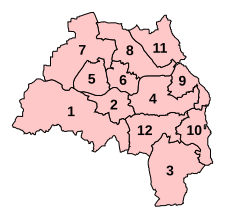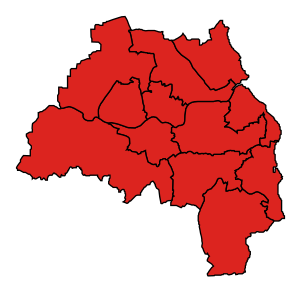The ceremonial county of Tyne and Wear is divided into 12 parliamentary constituencies. They are all borough constituencies. As of the 2019 general election, 11 in 12 are represented by the Labour Party (UK).
Constituencies edit
Conservative Labour Independent
| Constituency[nb 1] | Electorate[1] | Majority[2][nb 2] | Member of Parliament[2] | Nearest opposition[2] | Map | ||
|---|---|---|---|---|---|---|---|
| Blaydon | 67,853 | 5,531 | Liz Twist | Adrian Pepper |  | ||
| Gateshead | 64,449 | 7,200 | Ian Mearns | Jane MacBean |  | ||
| Houghton and Sunderland South | 68,835 | 3,115 | Bridget Phillipson | Christopher Howarth |  | ||
| Jarrow | 65,103 | 7,120 | Kate Osborne | Nick Oliver |  | ||
| Newcastle upon Tyne Central | 57,845 | 12,278 | Chinyelu Onwurah | Emily Payne |  | ||
| Newcastle upon Tyne East | 63,796 | 15,463 | Nick Brown[nb 3] | Robin Gwynn |  | ||
| Newcastle upon Tyne North | 68,486 | 5,765 | Catherine McKinnell | Mark Lehain |  | ||
| North Tyneside | 78,902 | 9,561 | Mary Glindon | Dean Carroll |  | ||
| South Shields | 62,793 | 9,585 | Emma Lewell-Buck | Oni Oviri |  | ||
| Sunderland Central | 72,680 | 2,964 | Julie Elliott | Tom D'Silva |  | ||
| Tynemouth | 77,261 | 4,857 | Alan Campbell | Lewis Bartoli |  | ||
| Washington and Sunderland West | 66,278 | 3,723 | Sharon Hodgson | Valerie Allen |  | ||
2010 boundary changes edit
Under the Fifth Periodic Review of Westminster constituencies, the Boundary Commission for England decided to reduce the number of seats in Tyne and Wear from 13 to 12, leading to significant changes. The constituencies of Gateshead East and Washington West, Houghton and Washington East, Sunderland North, Sunderland South, and Tyne Bridge were abolished and replaced with Gateshead, Houghton and Sunderland South, Sunderland Central, and Washington and Sunderland West. Newcastle upon Tyne East and Wallsend became Newcastle upon Tyne East.
| Former name | Boundaries 1997-2010 | Current name | Boundaries 2010–present |
|---|---|---|---|
 |  |
Future boundary changes edit
See 2023 Periodic Review of Westminster constituencies for further details.
Following the abandonment of the Sixth Periodic Review (the 2018 review), the Boundary Commission for England formally launched the 2023 Review on 5 January 2021.[3] Initial proposals were published on 8 June 2021 and, following two periods of public consultation, revised proposals were published on 8 November 2022. The final proposals were published on 28 June 2023.
The commission has proposed that Newcastle upon Tyne and North Tyneside be combined with Northumberland as a sub-region of the North East Region, with the creation of two cross-county boundary constituencies comprising an expanded Hexham seat and a new seat named Cramlington and Killingworth. Gateshead, South Tyneside and Sunderland would be combined with County Durham, resulting in another cross-county boundary constituency, named Blaydon and Consett. The constituencies of Blaydon, Gateshead, Jarrow, North Tyneside, Newcastle upon Tyne Central, Newcastle upon Tyne East, and Washington and Sunderland West would be abolished, and new or re-established constituencies of Gateshead Central and Whickham, Jarrow and Gateshead East, Newcastle upon Tyne Central and West, Newcastle upon Tyne East and Wallsend, and Washington and Gateshead South created.[4][5]
The following seats are proposed:
Containing electoral wards from Gateshead
- Blaydon and Consett (part)
- Gateshead Central and Whickham
- Jarrow and Gateshead East (part)
- Washington and Gateshead South (part)
Containing electoral wards from Newcastle upon Tyne
- Cramlington and Killingworth (parts also in North Tyneside and Northumberland)
- Hexham (part also in Northumberland)
- Newcastle upon Tyne Central and West
- Newcastle upon Tyne East and Wallsend (part)
- Newcastle upon Tyne North (part)
Containing electoral wards from North Tyneside
- Cramlington and Killingworth (parts also in Newcastle upon Tyne and Northumberland)
- Newcastle upon Tyne East and Wallsend (part)
- Newcastle upon Tyne North (part)
- Tynemouth
Containing electoral wards from South Tyneside
- Jarrow and Gateshead East (part)
- South Shields
Containing electoral wards from Sunderland
- Houghton and Sunderland South
- Sunderland Central
- Washington and Gateshead South (part)
Results history edit
Primary data source: House of Commons research briefing - General election results from 1918 to 2019[6]
2019 edit
The number of votes cast for each political party who fielded candidates in constituencies comprising Tyne and Wear in the 2019 general election were as follows:
| Party | Votes | % | Change from 2017 | Seats | Change from 2017 |
|---|---|---|---|---|---|
| Labour | 247,317 | 47.8% |  13.0% 13.0% | 12 | 0 |
| Conservative | 160,155 | 30.9% |  2.4% 2.4% | 0 | 0 |
| Brexit | 47,142 | 9.1% | new | 0 | 0 |
| Liberal Democrats | 36,417 | 7.0% |  3.0% 3.0% | 0 | 0 |
| Greens | 16,010 | 3.1% |  1.5% 1.5% | 0 | 0 |
| Others | 10,504 | 2.0% |  3.0% 3.0% | 0 | 0 |
| Total | 517,545 | 100.0 | 12 |
Percentage votes edit
| Election year | 1983 | 1987 | 1992 | 1997 | 2001 | 2005 | 2010 | 2015 | 2017 | 2019 |
|---|---|---|---|---|---|---|---|---|---|---|
| Conservative | 31.3 | 27.6 | 28.8 | 17.3 | 17.7 | 17.4 | 21.4 | 20.3 | 28.5 | 30.9 |
| Labour | 45.4 | 53.6 | 57.1 | 67.1 | 62.9 | 55.8 | 48.7 | 52.1 | 60.8 | 47.8 |
| Liberal Democrat1 | 23.3 | 18.6 | 13.7 | 11.8 | 16.6 | 23.2 | 21.7 | 5.5 | 4.0 | 7.0 |
| Green Party | - | * | * | * | * | * | 0.6 | 4.1 | 1.6 | 3.1 |
| UKIP | - | - | - | * | * | * | 1.8 | 17.3 | 4.7 | * |
| Brexit Party | - | - | - | - | - | - | - | - | - | 9.1 |
| Other | 0.1 | 0.3 | 0.4 | 3.8 | 2.8 | 3.6 | 5.8 | 0.7 | 0.3 | 2.0 |
11983 & 1987 - Alliance
* Included in Other
Seats edit
| Election year | 1983 | 1987 | 1992 | 1997 | 2001 | 2005 | 2010 | 2015 | 2017 | 2019 |
|---|---|---|---|---|---|---|---|---|---|---|
| Conservative | 2 | 1 | 1 | 0 | 0 | 0 | 0 | 0 | 0 | 0 |
| Labour | 11 | 12 | 12 | 13 | 13 | 13 | 12 | 12 | 12 | 12 |
| Total | 13 | 13 | 13 | 13 | 13 | 13 | 12 | 12 | 12 | 12 |
Maps edit
- 1983
- 1987
- 1992
- 1997
- 2001
- 2005
- 2010
- 2015
- 2017
- 2019
Historical representation by party edit
Conservative Independent Labour
| Constituency | 1983 | 85 | 1987 | 1992 | 1997 | 2001 | 2005 | 2010 | 13 | 2015 | 2017 | 19 | 2019 | 23 |
|---|---|---|---|---|---|---|---|---|---|---|---|---|---|---|
| Blaydon | McWilliam | Anderson | Twist | |||||||||||
| Gateshead East / Gd E & Washington W (1997) / Wn & Sunderland W (2010) | Conlan | Quin | Hodgson | |||||||||||
| Houghton and Washington / Hn & Wn E (1997) / Hn & Sunderland S (2010) | Boyes | Kemp | Phillipson | |||||||||||
| Jarrow | Dixon | Hepburn | → | Osborne | ||||||||||
| Newcastle upon Tyne Central | Merchant | Cousins | Onwurah | |||||||||||
| Newcastle upon Tyne East (1983-1997, 2010-) / & Wallsend (1997-2010) | N. Brown | → | ||||||||||||
| Newcastle upon Tyne North | R. Brown | Henderson | McKinnell | |||||||||||
| Wallsend / North Tyneside (1997) | Garrett | Byers | Glindon | |||||||||||
| South Shields | Clark | Miliband | Lewell-Buck | |||||||||||
| Sunderland North / Sunderland Central (2010) | Clay | Etherington | Elliott | |||||||||||
| Tyne Bridge / Gateshead (2010) | Cowans | Clelland | Mearns | |||||||||||
| Tynemouth | Trotter | Campbell | ||||||||||||
| Sunderland South | Bagier | Mullin | ||||||||||||
See also edit
Notes edit
References edit
- ^ Baker, Carl; Uberoi, Elise; Cracknell, Richard (28 January 2020). "General Election 2019: full results and analysis".
- ^ a b c "Constituencies A-Z - Election 2019". BBC News. Retrieved 23 April 2020.
- ^ "2023 Review". Boundary Commission for England. Retrieved 13 October 2021.
- ^ "Political boundaries across the North East could change - here's what it could mean for you". The Northern Echo. Retrieved 12 December 2022.
- ^ "The 2023 Review of Parliamentary Constituency Boundaries in England – Volume one: Report". Boundary Commission for England. paras 643-685. Retrieved 9 July 2023.
- ^ Watson, Christopher; Uberoi, Elise; Loft, Philip (17 April 2020). "General election results from 1918 to 2019".



